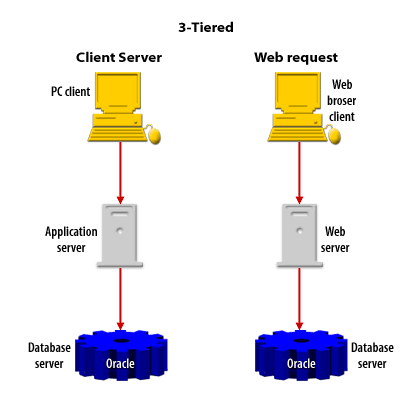| Lesson 6 | Tuning tips for Web-based Oracle connectivity |
| Objective | See how Oracle manages incoming Web requests. |
Tuning tips Web-based Oracle Connectivity
Oracle manages incoming web requests to Oracle databases in a variety of ways, depending on the specific configuration.
Some of the most common methods include:
Here is a simplified example of how Oracle might manage incoming web requests to a database:
- Oracle HTTP Server: Oracle HTTP Server (OHS) is a web server that can be used to route incoming web requests to Oracle databases. OHS can be configured to use a variety of different protocols, including HTTP, HTTPS, and WebDAV.
- Oracle WebLogic Server: Oracle WebLogic Server is an application server that can be used to host Oracle database applications. WebLogic Server can be configured to receive incoming web requests directly, or it can be configured to use OHS as a reverse proxy.
- Oracle Cloud Infrastructure (OCI) API Gateway: OCI API Gateway is a managed service that can be used to create and manage APIs. OCI API Gateway can be used to route incoming web requests to Oracle databases that are hosted in OCI.
Here is a simplified example of how Oracle might manage incoming web requests to a database:
- A user sends a web request to an Oracle web server.
- The web server routes the request to OHS.
- OHS forwards the request to an Oracle database.
- The database processes the request and returns a response to OHS.
- OHS forwards the response back to the web server.
- The web server returns the response to the user.
- Authentication and authorization: Oracle provides a variety of authentication and authorization mechanisms to control who can access Oracle databases and what they can do once they are authenticated.
- Auditing: Oracle provides auditing capabilities to track who is accessing Oracle databases and what they are doing.
- Security policies: Oracle provides a number of security policies that can be used to protect Oracle databases from unauthorized access and attack.
Replicated Environment in Web interfaces to Oracle
The Oracle Web architecture has steadily evolved over the past few years. Like all
very large database systems, most Web interfaces to Oracle databases use a replicated
environment. Critical tables are replicated with Oracle snapshots into separate database schemas, often on different database servers.
When a request is received, a customized Web listener directs the traffic to the least frequently used replicated database.
Remember to separate the performance issues associated with the WebServer from the Oracle database performance issues. The WebServer is an entirely separate piece of software with its own set of components, and is tuned independently from the Oracle database.
Remember to separate the performance issues associated with the WebServer from the Oracle database performance issues. The WebServer is an entirely separate piece of software with its own set of components, and is tuned independently from the Oracle database.
Web-based Applications and Client-server Applications
We can think of the models for Web-based applications and client-server applications as being very similar. A Web-based Oracle application can be viewed as a three-tiered client-server application.
The following diagram describes these similarities.
The following diagram describes these similarities.

- A client-server architecture has a PC-based client, just like the Web architecture.
- Just as a PC-client request will be intercepted by an application server, a Web-based request may be intercepted by a WebServer layer. This is known as the middle layer.
- Both the WebServer and the application layer format the request into an Oracle SQL data request and pass the request (via Net8) to the database server.
Tuning Tips - Exercise
Before we continue, let us test your knowledge of Oracle WebServer components and architecture with a matching Exercise.Tuning Tips - Exercise